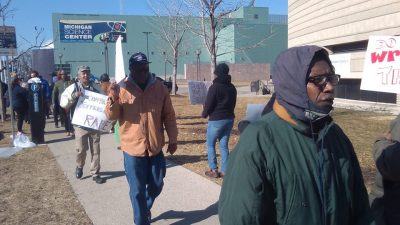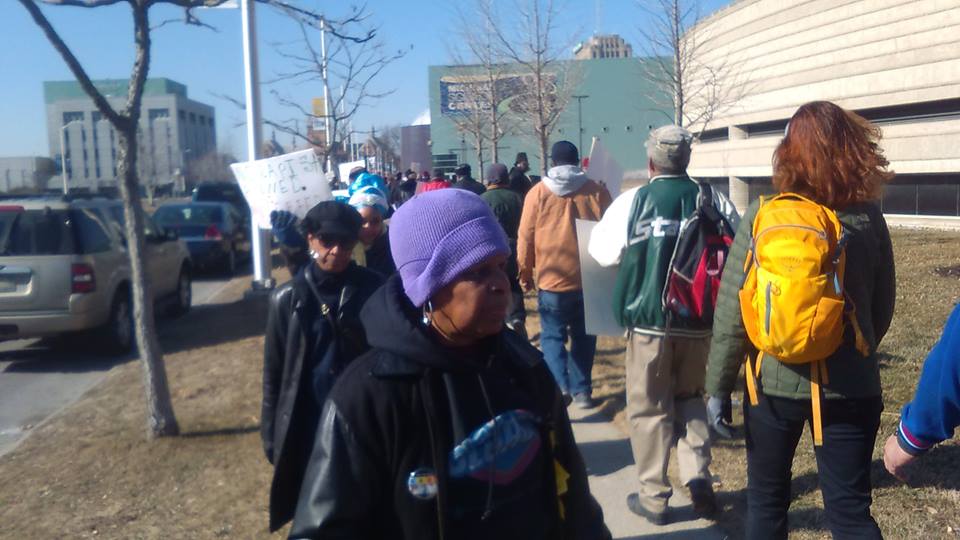Distorting American History: Jefferson Exhibit Generates Racial Controversy in Detroit
Legacy of the slave owning former president is being contested in the 21st century

An historical exhibit designed to examine various aspects of the life and people of the Monticello plantation in Virginia during the late 18th and early 19th centuries, which was owned by Thomas Jefferson, has prompted protests in Detroit.
Members of the Black Legacy Coalition (BLC) have held press conferences and made public statements objecting to the hosting of “Slavery at Jefferson’s Monticello: Paradox of Liberty” by the Dr. Charles H. Wright Museum of African American History located in the Midtown district of the city.
On March 12, approximately 100 people picketed the Wright Museum demanding that the Jefferson exhibit be reconsidered. Participants carried a banner challenging the official narrative and characterization of Jefferson.
Others held placards denouncing enslavement and the treatment of Sally Hemings, a woman of African descent owned by Jefferson who bore several children by the plantation owner.
The BLC plans to protest every day at 11:00am until the exhibit opens. This midday manifestation gained press coverage from several media outlets.
The exhibit is scheduled to begin on March 15 amid continuing efforts by the BLC to have the display cancelled. Members of the BLC and others feel that the character of the exhibit attempts to cover up the horrors of African enslavement including the systematic sexual exploitation of African women.
In a press release issued on Dr. Martin Luther King, Jr. Day (Jan. 21) in Detroit held at the St. Matthew’s & St. Joseph’s Episcopal Church on Woodward Avenue, the BLC noted that:
“The Coalition stands on the immortal, sacred legacy of Rev. Dr. Martin Luther King, Jr. and Dr. Charles H. Wright to preserve and protect the CHW Museum against any effort to ‘romanticize’ the terrorism forced upon those forcibly enslaved, like Sally Hemings, or the duplicitous depiction of a ‘patriarchal narrative’ to shroud the brutality and inhumanity of enslavers like Thomas Jefferson, who ‘owned’ 600 Africans while penning that ‘all men are created equal.’”
This exhibit began in 2012 at the Smithsonian American Museum of History in Washington, D.C. Over the last seven years it has been hosted by several cities including St. Louis, Philadelphia and Dallas.
Jefferson: Co-Author of the Declaration of Independence and early U.S. Politician
This issue is being raised during the 400th anniversary of the enslavement of Africans beginning in the former British colony of Virginia in August 1619, which later became the U.S. Jefferson was a co-author of the Declaration of Independence and served as Governor of Virginia in the Continental Congress, secretary of state, secretary of war, minister of state to France and vice-president prior to becoming the third president of the U.S.
According to language in the “Slavery at Jefferson’s Monticello: Paradox of Liberty” promotional materials:
“As many as 70 members of the Hemings family lived in slavery at Monticello over five generations. Elizabeth Hemings (1735–1807) and her children arrived at Monticello around 1774 as part of Jefferson’s inheritance from his father-in-law, John Wayles, who was likely the father of six of the children.” (See this)
The same document continues by pointing out:
“Members of the family eventually occupied the most important positions in Monticello’s labor force. They helped build the Monticello house, ran the household, made furniture, cooked Jefferson’s meals, cared for his children and grandchildren, attended to him in his final moments, and dug his grave. Elizabeth’s daughter Sally Hemings was likely the mother of four of his children. The nine people Jefferson freed in his lifetime and will were all members of the Hemings family.”
Although the brochure acknowledges the indispensable nature of slave labor in the operation of the plantation, it fails to categorically condemn the triangular trade as an economic system which eventually led to the development of industrial capitalism in both Western Europe and North America. By framing slavery as essentially a moral question, the exhibit neglects the principal role of the exploitation of African people in the growth and expansion of the U.S. into the leading imperialist power by the mid-20th century. (See this)
Many accounts of Jefferson’s life extol his mastery of law, architecture, mathematics, agriculture and other professional fields. He signed the documents outlawing the importation of enslaved Africans into the U.S. in 1807, although the system continued long after his death and only ended with the Civil War fought during 1861-1865. As early as 1788 he was said to have banned the importation of enslaved Africans into the state of Virginia.
Detroit demonstration against Jefferson slavery exhibit on March 12, 2019
Nonetheless, his views on African people state clearly that he felt they were inherently inferior to whites in both beauty and intelligence. He did not believe that Africans could be integrated into U.S. society and supported the gradual training and freeing of Africans where they could possibly be sent to live in Santo Domingo. Jefferson believed that the ending of slavery would cause unrest in the U.S.
In one of Jefferson’s most widely read books, “Notes on the State of Virginia”, published in 1785, the leading politician and wealthy slave owner expressed the general fears among the ruling class that the potential for war between the races was highly probable. Therefore, he advocated the colonization of Africans on the continent or in other regions of the world.
One passage in “Notes on the State of Virginia” emphasizes:
“It will probably be asked, Why not retain and incorporate the blacks into the state, and thus save the expense of supplying, by importation of white settlers, the vacancies they will leave? Deep rooted prejudices entertained by the whites; ten thousand recollections, by the blacks, of the injuries they have sustained; new provocations; the real distinctions which nature has made; and many other circumstances, will divide us into parties, and produce convulsions which will probably never end but in the extermination of the one or the other race.” (See this)
By 1816, there was the formation of the American Colonization Society (ACS) which resettled thousands of willing Africans who felt there was no hope for an independent and free existence in the U.S., in the West African region which became known as Liberia. The country was declared independent in 1847. However, up until the modern era, Liberia has remained under the economic and political dominance of Washington.
Despite the purported prohibition on the Atlantic trade in African people after the first decade of the 19th century, slavery expanded exponentially utilizing both “illegal” importations and domestic breeding, where by 1861 four million Africans were subjected to bondage.
General Demands of the BLC
The struggle over the Jefferson exhibit is part of broader demands related to the governance and programmatic character of the Wright Museum, which was the largest of its kind in the U.S. prior to the opening of the Smithsonian Institution’s National Museum of African American History and Culture in Washington during 2016. The Wright Museum was the outgrowth of the decades-long work of Dr. Charles H. Wright, an area physician, who built the institution through memberships and eventual recognition by the City of Detroit government under its first African American Mayor Coleman A. Young.
BLC has called for the appointment of community members to the board of the Wright Museum. The Coalition is charging that the board has become corporate dominated and non-representative of the city of Detroit which has a more than 80% African American population.
*
Note to readers: please click the share buttons below. Forward this article to your email lists. Crosspost on your blog site, internet forums. etc.
Abayomi Azikiwe is the editor of Pan-African News Wire. He is a frequent contributor to Global Research.
All images in this article are from the author



